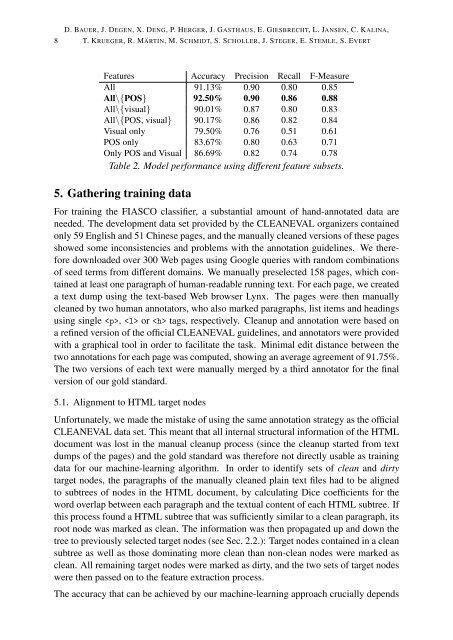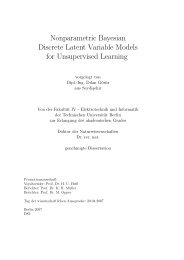FIASCO: Filtering the Internet by Automatic Subtree Classification ...
FIASCO: Filtering the Internet by Automatic Subtree Classification ...
FIASCO: Filtering the Internet by Automatic Subtree Classification ...
You also want an ePaper? Increase the reach of your titles
YUMPU automatically turns print PDFs into web optimized ePapers that Google loves.
8<br />
D. BAUER, J. DEGEN, X. DENG, P. HERGER, J. GASTHAUS, E. GIESBRECHT, L. JANSEN, C. KALINA,<br />
T. KRUEGER, R. MÄRTIN, M. SCHMIDT, S. SCHOLLER, J. STEGER, E. STEMLE, S. EVERT<br />
Features Accuracy Precision Recall F-Measure<br />
All 91.13% 0.90 0.80 0.85<br />
All\{POS} 92.50% 0.90 0.86 0.88<br />
All\{visual} 90.01% 0.87 0.80 0.83<br />
All\{POS, visual} 90.17% 0.86 0.82 0.84<br />
Visual only 79.50% 0.76 0.51 0.61<br />
POS only 83.67% 0.80 0.63 0.71<br />
Only POS and Visual 86.69% 0.82 0.74 0.78<br />
Table 2. Model performance using different feature subsets.<br />
5. Ga<strong>the</strong>ring training data<br />
For training <strong>the</strong> <strong>FIASCO</strong> classifier, a substantial amount of hand-annotated data are<br />
needed. The development data set provided <strong>by</strong> <strong>the</strong> CLEANEVAL organizers contained<br />
only 59 English and 51 Chinese pages, and <strong>the</strong> manually cleaned versions of <strong>the</strong>se pages<br />
showed some inconsistencies and problems with <strong>the</strong> annotation guidelines. We <strong>the</strong>refore<br />
downloaded over 300 Web pages using Google queries with random combinations<br />
of seed terms from different domains. We manually preselected 158 pages, which contained<br />
at least one paragraph of human-readable running text. For each page, we created<br />
a text dump using <strong>the</strong> text-based Web browser Lynx. The pages were <strong>the</strong>n manually<br />
cleaned <strong>by</strong> two human annotators, who also marked paragraphs, list items and headings<br />
using single , or tags, respectively. Cleanup and annotation were based on<br />
a refined version of <strong>the</strong> official CLEANEVAL guidelines, and annotators were provided<br />
with a graphical tool in order to facilitate <strong>the</strong> task. Minimal edit distance between <strong>the</strong><br />
two annotations for each page was computed, showing an average agreement of 91.75%.<br />
The two versions of each text were manually merged <strong>by</strong> a third annotator for <strong>the</strong> final<br />
version of our gold standard.<br />
5.1. Alignment to HTML target nodes<br />
Unfortunately, we made <strong>the</strong> mistake of using <strong>the</strong> same annotation strategy as <strong>the</strong> official<br />
CLEANEVAL data set. This meant that all internal structural information of <strong>the</strong> HTML<br />
document was lost in <strong>the</strong> manual cleanup process (since <strong>the</strong> cleanup started from text<br />
dumps of <strong>the</strong> pages) and <strong>the</strong> gold standard was <strong>the</strong>refore not directly usable as training<br />
data for our machine-learning algorithm. In order to identify sets of clean and dirty<br />
target nodes, <strong>the</strong> paragraphs of <strong>the</strong> manually cleaned plain text files had to be aligned<br />
to subtrees of nodes in <strong>the</strong> HTML document, <strong>by</strong> calculating Dice coefficients for <strong>the</strong><br />
word overlap between each paragraph and <strong>the</strong> textual content of each HTML subtree. If<br />
this process found a HTML subtree that was sufficiently similar to a clean paragraph, its<br />
root node was marked as clean. The information was <strong>the</strong>n propagated up and down <strong>the</strong><br />
tree to previously selected target nodes (see Sec. 2.2.): Target nodes contained in a clean<br />
subtree as well as those dominating more clean than non-clean nodes were marked as<br />
clean. All remaining target nodes were marked as dirty, and <strong>the</strong> two sets of target nodes<br />
were <strong>the</strong>n passed on to <strong>the</strong> feature extraction process.<br />
The accuracy that can be achieved <strong>by</strong> our machine-learning approach crucially depends

















